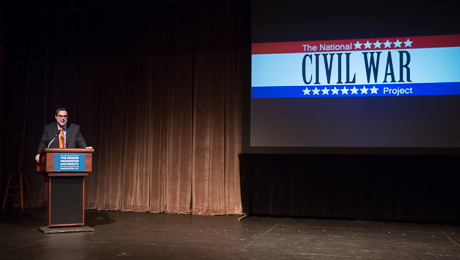This year marks the 150th anniversary of the Civil War—and the George Washington University has honored its memory this week through theater, dance and music performances, as well as scholarly presentations.
The George Washington University and Arena Stage hosted the National Civil War Project Conference as part of the National Civil War Project, a partnership aimed at exploring the American Civil War and its aftermath by combining academic work with artistic performances.
The project has been the catalyst for creating three other partnerships between universities and performance organizations, which include the Alliance Theatre and the Emory College Center for Creativity & Arts at Emory University; Baltimore’s Centerstage and the University of Maryland’s Clarice Smith Performing Arts Center; and the American Repertory Theater and Harvard University.
“I think that creating performances around the events of the Civil War and emphasizing the stories that we don't know much about—many of which were the focus of our conference sessions—will give people the opportunity to experience our history rather than simply reading about it, as well as enabling us to make personal connections between the past and the present,” said Professor of Theatre Leslie Jacobson, one of the event’s organizers.
The two-day conference was held on Monday and Tuesday to showcase the many ways GW has committed to the National Civil War Project, in partnership with Arena Stage. The agenda boasted performances by Arena Stage’s youth troupe and GW students, discussions with faculty experts and a lecture and book signing with James Swanson, the best-selling author of “Manhunt: The 12 Day Chase for Lincoln’s Killer.”
A variety of sessions examined how other wars and conflicts are related to the Civil War. In the conference’s opening session, choreographer Liz Lerman, M.A. '82, discussed her theater and dance piece, “Healing Wars,” which depicts how soldiers from the Civil War, Iraq and Afghanistan have coped with physical and emotional combat wounds. The piece opens in June at Arena Stage. Professor Nina Seavey, director of the George Washington University’s Documentary Center, then debuted a short preview of her documentary based on Ms. Lerman’s “Healing Wars.”
“GW is indeed building a dynamic profile in the arts,” Columbian College of Arts and Sciences Dean Ben Vinson III said at the opening session. “The Civil War Project represents a collaboration of scholars and artists which can have enormous impact on the ways that research and artistic expression manifest themselves.”
Mr. Swanson outlined what he learned while writing “Manhunt: The 12-Day Chase for Lincoln’s Killer” and its 2011 follow-up, “Bloody Crimes: The Funeral of Abraham Lincoln and the Chase for Jefferson Davis.” He explained the connection between President Abraham Lincoln and Jefferson Davis, two figures who represent contrasting sides of the Civil War.
Mr. Davis served as president of the Confederate States of America, while President Lincoln fought relentlessly for the Union. Although they supported opposite causes, both men had more in common than Mr. Swanson ever would have imagined. They were both born in Kentucky, less than a year apart. They shared the same physicality—tall, thin and even described as “half-starved.” They also suffered tremendous sadness after losing close loved ones.
More importantly, they both were obstinate in their beliefs, a quality so intense that Mr. Swanson even found it disturbing. Both would stay up at night, Mr. Swanson described, plotting how they would win the war—even if victory resulted in huge numbers of dead and wounded.
“Without condemning them or undermining them, but simply as a fact, we have to conclude they were the two greatest killers in American history,” Mr. Swanson said. “Each was willing to send hundreds of thousands of men to their deaths to vindicate their principles.”
The two men also represent just how polarizing and controversial the subject is among Americans. Mr. Swanson said that there has been little done nationwide to commemorate the 150th anniversary, partially because leaders have tried to avoid the debates the war sparks.
“It feels to me like it’s a limited celebration that’s not capturing the national imagination. It’s not part of the national conversation as I think it should be,” he said.
However, the conference demonstrated how GW is taking initiative and thinking of new ways to bring the Civil War into the collective consciousness. Professor of History Tyler Anbinder chronicled how the Civil War influenced modern-day D.C. Using his research, Dr. Anbinder will help organize one of the first exhibits at the new George Washington University Museum and The Textile Museum featuring artifacts from the Albert H. Small Washingtoniana Collection.
John Wetenhall, director of the new museum, said many future exhibits will be collaborative efforts that will include faculty members and experts like Dr. Anbinder.
“GW has wonderful resources to interpret Civil War objects and make them accessible to the public, and it has a backbone in museum studies to be able to develop exhibitions at a high professional level,” Dr. Wetenhall said.
“Healing in the Aftermath,” another panel, featured Ms. Jacobson, sociology professor Fran Buntman and English professors Jennifer James and James Miller in a discussion of how the Reconstruction era following the Civil War shaped race and gender dynamics in the U.S. The panelists compared America’s history to the struggle against apartheid in South Africa.
“With two full days of conference sessions, participants were able to immerse themselves intensely in a number of intriguing topics—and to uncover some new areas of exploration which will, hopefully, continue into the future,” Ms. Jacobson said.


